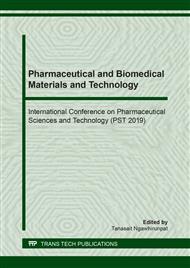p.163
p.169
p.175
p.181
p.187
p.195
p.202
p.209
p.215
Design of Caffeine-Loaded Nanostructured Lipid Carriers Containing Coconut Oil for Topical Application
Abstract:
Although caffeine was suggested as one of the pharmacological agents for the cellulite treatment, its skin permeation restricted. The present work was aimed at formulating caffeine loaded nanostructured lipid carriers (CAF-NLCs) containing coconut oil as a topical delivery system. CAF-NLCs were prepared by the ultrasonic emulsification method, using coconut oil as a liquid lipid. The proper selection of solid lipid and surfactants for these formulations were investigated. Subsequently, physicochemical properties, entrapment efficacy, stability, and in vitro drug release were evaluated. The CAF-NLCs containing coconut oil was successfully prepared using glyceryl behenate as a solid lipid and showed an interesting entrapment efficiency (62-99%). The obtained CAF-NLCs presented the nanosized range (≈ 60-390 nm), with a low polydispersity index and high negative zeta potential values (over ‐30 mV). However, the type and concentration of surfactant also affected these properties. These results suggested that CAF-NLCs containing coconut oil are the promising carrier for delivery of caffeine following topical application.
Info:
Periodical:
Pages:
187-192
Citation:
Online since:
August 2019
Keywords:
Price:
Сopyright:
© 2019 Trans Tech Publications Ltd. All Rights Reserved
Share:
Citation:


